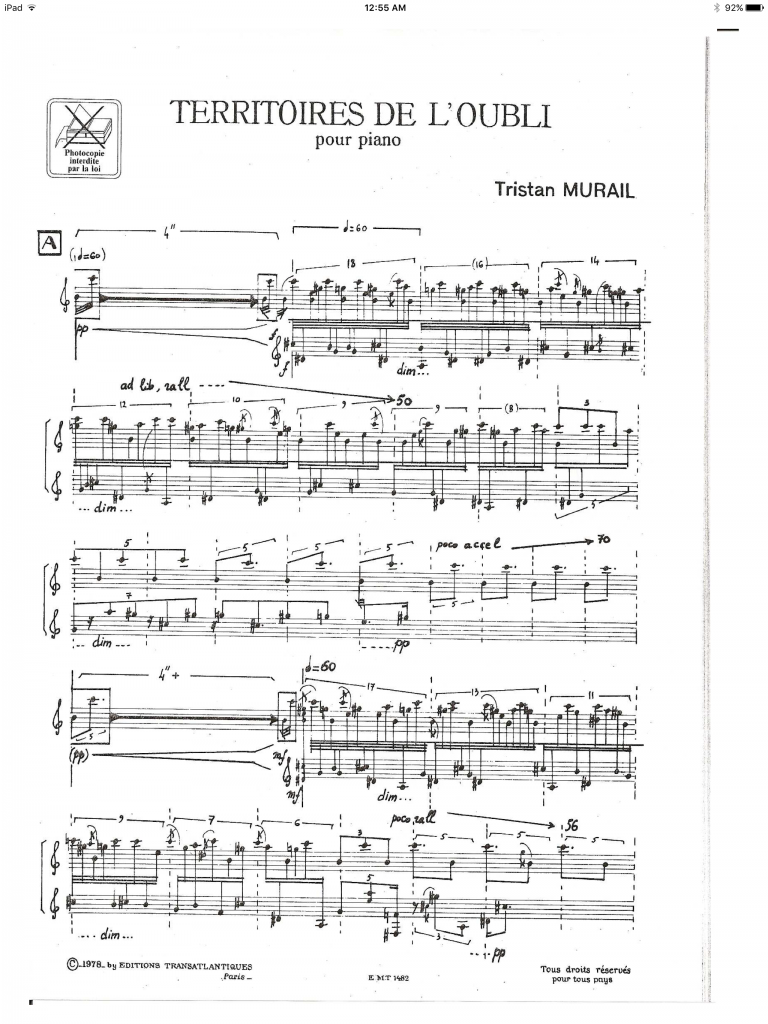
Murail’s “Territoires de l’oubli” is a centerpiece of Marilyn Nonken’s book The Spectral Piano: From Liszt, Scriabin, and Debussy to the Digital Age (Cambridge, 2014). Although the book’s purpose is to sketch a wider and deeper genealogy for spectralism, Nonken places Murail, and specifically “Territoires de l’oubli” at the heart of the movement. The book’s strength is its argument—repeated in many varying forms, almost like a spectral “motif” whose purpose is to produce resonance rather than move like a melody through time—that there has been a strain of pianism, beginning with late Romanticism, in which the piano is not a “percussive” instrument, but rather one with a particular set of aural qualities. Here is one of many passages that present a form of her argument:
A spectral attitude towards the piano asserts that the most compelling acoustic phenomena producible by the instrument are not those generated by increasingly eclectic forms of attack but those associated with the piano’s defining attribute: the decay of sound. The emphasis on the piano’s primarily percussive qualities, exemplified by such works as Boulez’s Deuxième sonate (1947-48) and Adams’s Phrygian Gates (1977-78), was replaced by a radical focus on resonant phenomena and sympathetic vibration. Murail wrote Territoires de l’oubli for the resonances and not for the attacks, the latter of which he described in its preface as “scars” (cicatrices) on the sonic continuum. His attitude, and that of those who adopted and were influenced by it, heralded a return to a keyboard-based virtuosity. [p. 113]
Nonken has some memorable and persuasive critiques of “percussive” piano works scattered through the book (for example, she dismisses Ligeti’s piano pieces as recherché), and The Spectral Piano accumulates a persuasive genealogy of piano work that pays attention to the acoustics of the piano.
There is a parallel available in classical rhetoric for the form of Nonken’s argument: Aristotle divided speech into logos (the matter of speech) and lexis (the manner), and lexis in turn into diegesis (representations of speech) and mimesis (direct presentations of speech). Diegesis then includes all represented action—in modern terms it would include fictional narrative, indirect and free indirect narration, and so forth. Mimesis, in Aristotle’s sense, is simply direct speech: things people say, presented in quotation marks. In its strongest form, Nonken’s argument is that the piano has been misunderstood as a diegetic instrument, in that it has always been understood as an instrument that emulates—represents—either the melodic and harmonic ideal of the human voice, or else the rhythmic ideal of percussion. Her argument is anti-diegetic: the piano is what it is, and should not be taken as an anthropomorphic or imitative instrument.
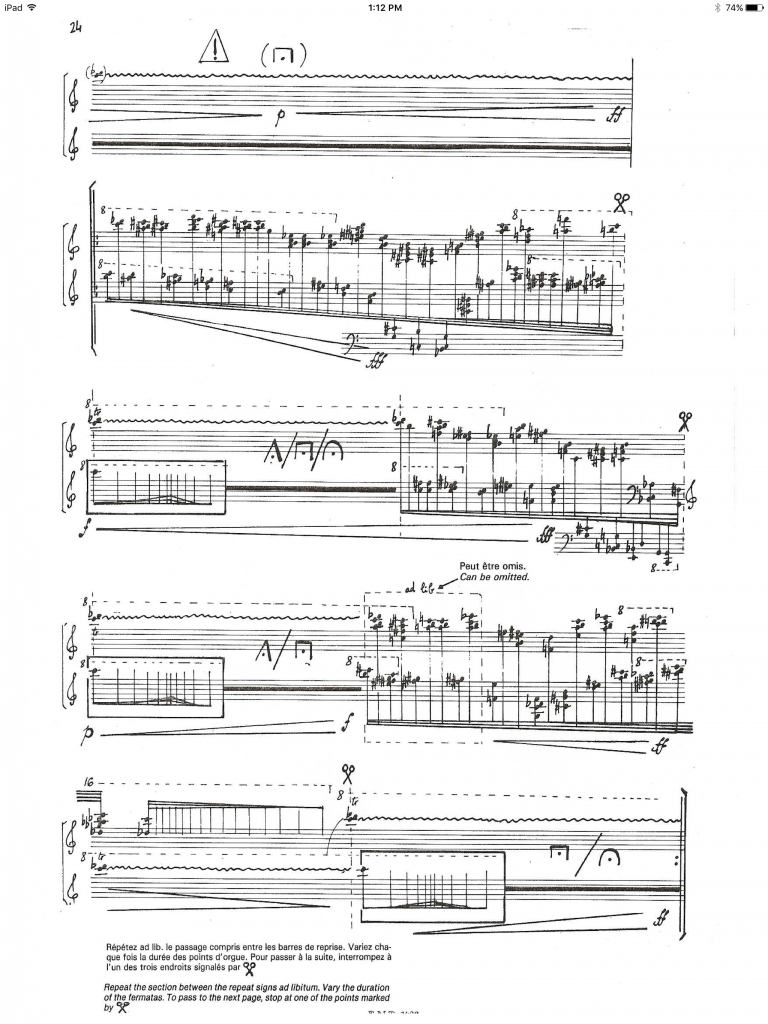
The Spectral Piano is also persuasive on the subject of the history of spectralism, and its importation into New York. There is no parallel for this “French invasion” in the visual arts, except for several marginal attempts, beginning in the 1980s, to reintroduce postwar French support-surface. Nonken’s book is itself a parallel to the visual arts, however, in its attempt to embrace aspects of aleatoric and sound art into the history of spectralism. She describes her own career as a turn from “uptown” music (including late modernism, Carter, Boulez, Babbitt, and New Complexity) to “downtown” music (meaning Cage, Lucier, Feldman, and others associated with minimalism and aleatoric practices). In that sense it’s as if the trajectory of her own performance practice—which culminated with a “downtown” position, at NYU—is an instance of the choice made by a number of art historians and theorists in relation to the visual arts.
All this is engaging as history. A problem emerges when it comes to describing the achievements of spectralism in a more specific way, rather than by noting its objections to traditional uses of the piano, or its inclination toward the piano’s characteristic resonance and decay. Unless the sonic capacities of the piano are to be imagined as a sort of je ne sais quoi, or, in painterly terms, a kind of sfumato of sense—as something beyond verbal articulation—then there should be ways of pointing to what spectral compositions produce. “Territoires de l’oubli” is crucial in this regard, because it is presented as a central work of spectralism’s most important composer. (The chapter is taken from an earlier essay in which Nonken makes similar claims, saying “Territoires” is an “epic study in resonance.” See “‘La Notation Ne Peut Rendre Compte Du Fait’: Performing Murail’s ‘Territoires De L’Oubli’,” Tempo, 2008.)
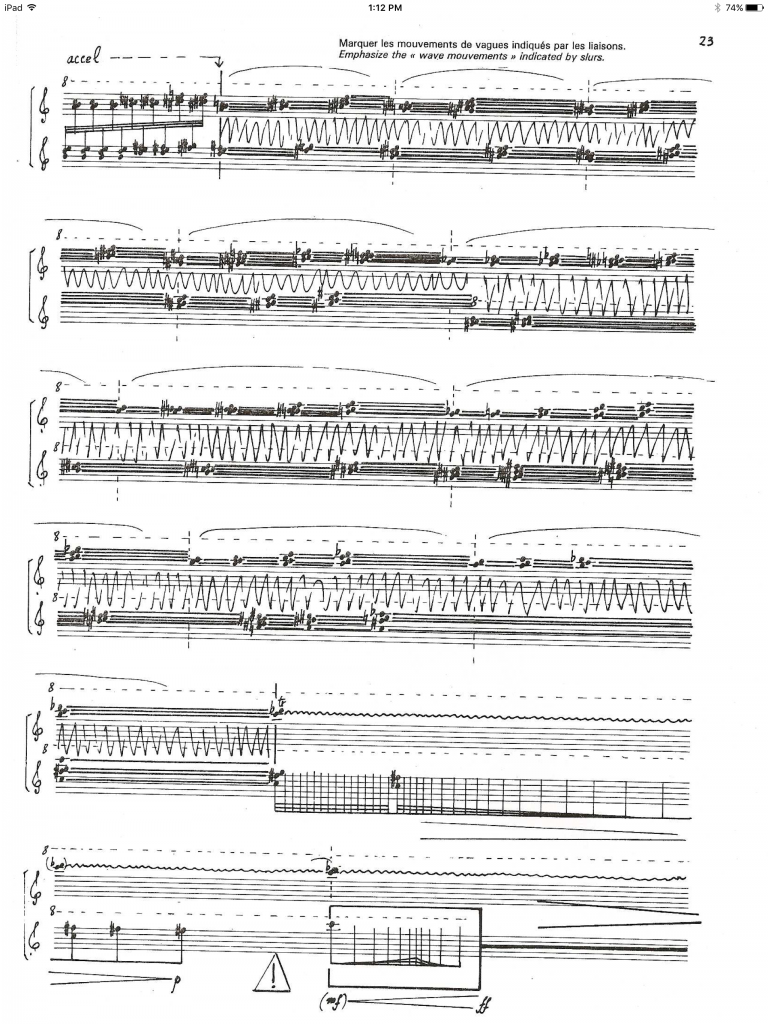 Nonken initially says “Territoires” “bears witness to Murail’s growing fascination with the microstructure of sound and the relationships among the components of a sound’s overtone structure as they develop in time” (p. 77). Harmonic and inharmonic overtones, especially in the gradual, pedaled decay of a piano, are a good example of a sound phenomenon that is impossible to capture in words, but entirely possible to capture in mathematics: that is, we can identify the overtones at play in a complex decaying resonance, even if it isn’t possible to describe the entirety of the effect, or to name every overtone.
Nonken initially says “Territoires” “bears witness to Murail’s growing fascination with the microstructure of sound and the relationships among the components of a sound’s overtone structure as they develop in time” (p. 77). Harmonic and inharmonic overtones, especially in the gradual, pedaled decay of a piano, are a good example of a sound phenomenon that is impossible to capture in words, but entirely possible to capture in mathematics: that is, we can identify the overtones at play in a complex decaying resonance, even if it isn’t possible to describe the entirety of the effect, or to name every overtone.
In “Territoires,” Nonken says,
The damper pedal is depressed from the first measure to the last. Over nearly thirty minutes, a body of resonance is created, sustained, and manipulated through an astonishing array of pianistic techniques: intricate passagework, batteries of chords, repeated notes, arpeggiations, trills, looping figures, tremolandi, and ostinasti. Alone and in dazzling combination, these techniques trigger acoustic phenomena rarely heard from the instrument. Notes never struck emerge from the texture, resulting not from the attacks but from sympathetic vibrations. Pitches that exceed the piano’s tessitura hover, canopy-like, over the resonance: phantom pitches produced through the interaction of harmonics. Despite the instrument’s inflexible temperament, its harmonies exhibit a microtonal cast, revealing Murail’s canny exploitation of complex low-register sonorities. [p. 77]
There are a number of phenomena here that could be pointed out in the score. The compromises of equal temperament will certainly produce “microtonal” resonances. Higher-order harmonics would definitely be produced by some of the loud, repeated, multitonal chords and figurations in the score. But Nonken does not give any example of any of these phenomena. Her analysis focuses on the score’s complex and unusual notation, and its graphic elements, “unprecedented in their specificity (p. 78).” She notes that Murail’s notation, “meticulous, written and overwritten,” and his many performance notes, especially those that ask for an uneven rhythm, point to a “plastic, Bergsonian conception of musical temporality” (p. 79).
Nonken’s musical examples are intended to demonstrate the unusual combination of “meticulous” notation and performative freedom that Murail felt he needed. “The composition’s first measures,” she writes, “designate pitches but only suggest their rhythmic articulation.” (See the first page, reproduced at the top of this post.)
She notes that the “gesture” of an oscillating ninth (B-C) is repeated with several variations in the score’s opening pages. “He specifies neither the number of oscillations between pitches, their rhythm, nor their acceleration.” (See the example below.)
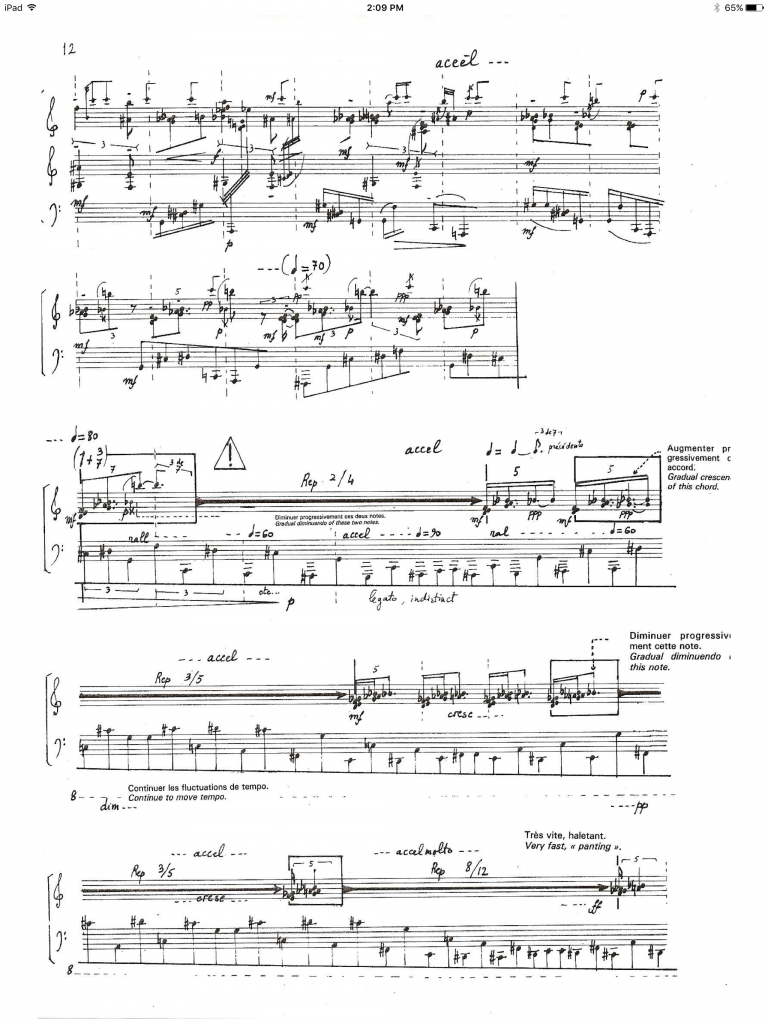
“Other passages,” she observes, “are even more vague”:
The exclamation point on the third system of the score’s twelfth page marks the beginning of an aleatoric passage in which the hands, unsynchronized, enact different gestural, dynamic, and temporal transformations… The left hand’s activities are carefully notated. However, Murail almost entirely foregoes notating those of the right.” [p. 79]
This analysis does two things at once: it suggests how Murail’s score diverges from New Complexity (Nonken gives Finnissy as an example) and has affinities with Cage and others; and it implies that tremendously complex phenomena are the point of the score’s experimentalism. But there is no example in Nonken’s analysis of any overtone, resonance, “phantom pitch,” or other “acoustic phenomenon.” The fact that timbre and harmonics are especially difficult to put into words does not mean the historian, theorist, or critic is relieved of the obligation to provide examples. If the central concerns of Murail’s spectralism are sounds that are taken to be beyond the capacity of musical analysis, or if the concerns of spectralism in general—from Liszt and Debussy onward—are understood to be sounds that cannot be specified in the languages of music theory, then it is the historian’s obligation to say what, for any given composer or in any given piece, counted as a phenomenon that is beyond words. In 17th century préciosité there was a theory of the je ne sais quoi: it was known as what was outside of rhetoric and logic, so its boundaries were well articulated. The same can be said of sfumato and its later developments, which took place against the contrast of academic art theory. What is missing in Nonken’s book is therefore not necessarily a complex, Easley Blackwood-style analysis of every elusive harmonic, but examples of specific nameable overtones and effects produced by particular passages. Nonken could for example have produced a version of the kind of analysis Richard Beaudoin applies to a passage in Finnissy’s “History of Photography in Sound” (“Anonymous Sources: Finnissy Analysis and the Opening of Chapter Eight of ‘The History of Photography in Sound,'”Perspectives of New Music, 2007).
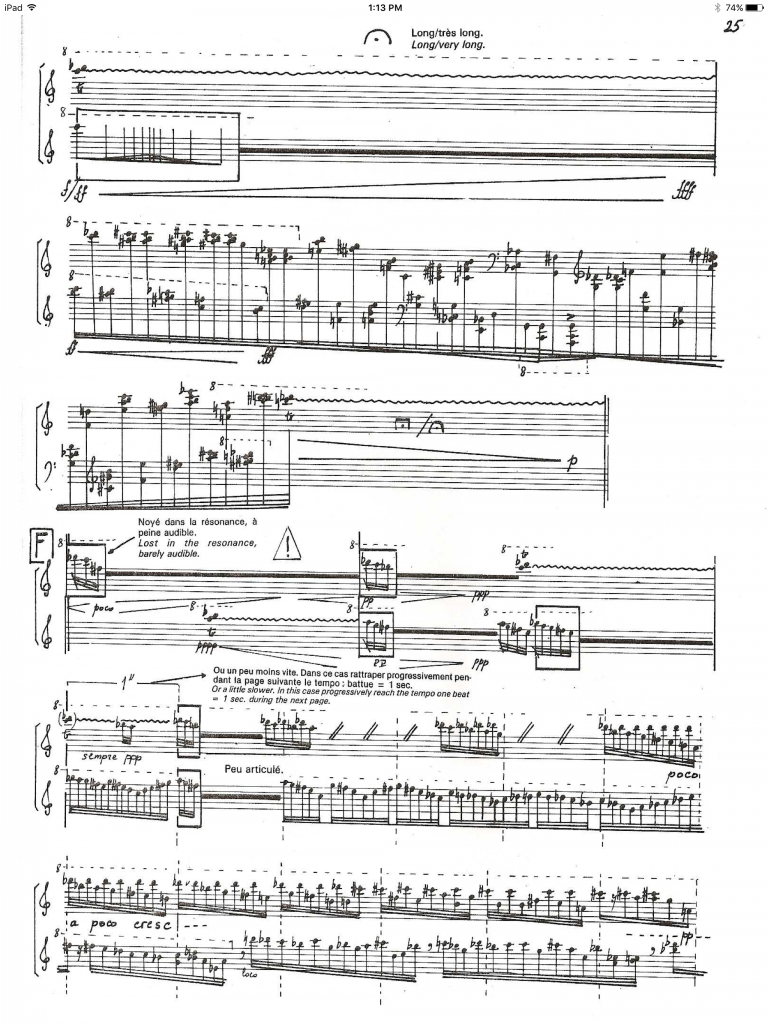 In the absence of such examples, or of an attempt to conjure some of the music’s “unprecedented,” “complex” sounds, and aside from the large academic literature that has grown up to theorize spectralism, I can only register Murail’s interest in producing new resonances and timbral combinations. “Territoires” does treat me to unusual aural experiences, but then again so do the late sonatas of Stockhausen and Sciarrino, and for that matter so do Ferneyhough’s and Carter’s piano pieces, as resolutely “percussive” as they are.
In the absence of such examples, or of an attempt to conjure some of the music’s “unprecedented,” “complex” sounds, and aside from the large academic literature that has grown up to theorize spectralism, I can only register Murail’s interest in producing new resonances and timbral combinations. “Territoires” does treat me to unusual aural experiences, but then again so do the late sonatas of Stockhausen and Sciarrino, and for that matter so do Ferneyhough’s and Carter’s piano pieces, as resolutely “percussive” as they are.
Nonken’s analysis also begs the question of large-scale structure that has been repeatedly raised in relation to spectralism. If timbre, decay, and resonance are the music’s point, then what justifies the length of a piece, or creates coherence on a large scale? This question may well be poorly formed, in that spectralism’s purpose is partly to divert attention from the large-scale structures that classical tonality enabled. But there is another way to attend to “Territoires,” which is not easy to reconcile with attention to timbre and harmonics: I mean listening to the work’s insistent crescendi and decrescendi. The piece is built on waves of accelerating and increasingly loud repetitions, as well as on receding waves of sound that slow and linger. Despite the negative connotations of the word “percussive” in this context, percussive is exactly what “Territoires” is, especially in its reverberating final ten minutes, in which fortissimo D#-C# chords are repeated in varying rhythms while everything around them melts. The work is brutally strong in this regard: it makes “Allegro Barbaro” or the end of “The Rite of Spring” seem domestic by comparison.
 It is even possible, I think, to picture the work’s overall structure as a series of approaches to the overwhelming crescendo of the last ten minutes, just as the various moments of reverberating silence can be seen as rehearsals for the long decay of the final page. I don’t offer this as a substitute for the purposes Nonken and others see in “Territoires” or other spectral compositions: I only think that a full account of Murail’s spectralism cannot be persuasive without taking note of its ferocious, nearly demented temporal dynamics. The work’s “territories” of sound do produce resonances, which are hard to describe: but they’re epiphenomenal on the “astonishing array of pianistic techniques” that are said to exist only to support them.
It is even possible, I think, to picture the work’s overall structure as a series of approaches to the overwhelming crescendo of the last ten minutes, just as the various moments of reverberating silence can be seen as rehearsals for the long decay of the final page. I don’t offer this as a substitute for the purposes Nonken and others see in “Territoires” or other spectral compositions: I only think that a full account of Murail’s spectralism cannot be persuasive without taking note of its ferocious, nearly demented temporal dynamics. The work’s “territories” of sound do produce resonances, which are hard to describe: but they’re epiphenomenal on the “astonishing array of pianistic techniques” that are said to exist only to support them.
*
In terms of performance: the piece is very demanding: it is 30 minutes long; it’s in manuscript; there are many special notations; and the notes are often small. However the difficulty of performance depends largely on the same issues I have been exploring here: a performance that is intent on producing as many effects of resonance and decay as possible, and even in controlling some of those effects (for example, to bring out certain harmonics), could become vertiginously difficult. I imagine that is the kind of performance Nonken has in mind. But a performance aiming at dynamics, suspense, “percussion,” and the creation of shimmering walls of sound, could in theory be significantly less difficult. In other words: what it means to play this piece well depends on how the performer understands the content of spectralism.